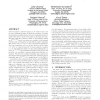Free Online Productivity Tools
i2Speak
i2Symbol
i2OCR
iTex2Img
iWeb2Print
iWeb2Shot
i2Type
iPdf2Split
iPdf2Merge
i2Bopomofo
i2Arabic
i2Style
i2Image
i2PDF
iLatex2Rtf
Sci2ools
STOC
2007
ACM
2007
ACM
Hardness of routing with congestion in directed graphs
Given as input a directed graph on N vertices and a set of source-destination pairs, we study the problem of routing the maximum possible number of source-destination pairs on paths, such that at most c(N) paths go through any edge. We show that the problem is hard to approximate within an N(1/c(N)) factor even when we compare to the optimal solution that routes pairs on edge-disjoint paths, assuming NP doesn't have NO(log log N) -time randomized algorithms. Here the congestion c(N) can be any function in the range 1 c(N) log N/ log log N for some absolute constant > 0. The hardness result is in the right ballpark since a factor NO(1/c(N)) approximation algorithm is known for this problem, via rounding a natural multicommodity-flow relaxation. We also give a simple integrality gap construction that shows that the multicommodity-flow relaxation has an integrality gap of N(1/c) for c ranging from 1 to ( log n log log n ). A solution to the routing problem involves selecting whi...
| Added | 03 Dec 2009 |
| Updated | 03 Dec 2009 |
| Type | Conference |
| Year | 2007 |
| Where | STOC |
| Authors | Julia Chuzhoy, Venkatesan Guruswami, Sanjeev Khanna, Kunal Talwar |
Comments (0)

